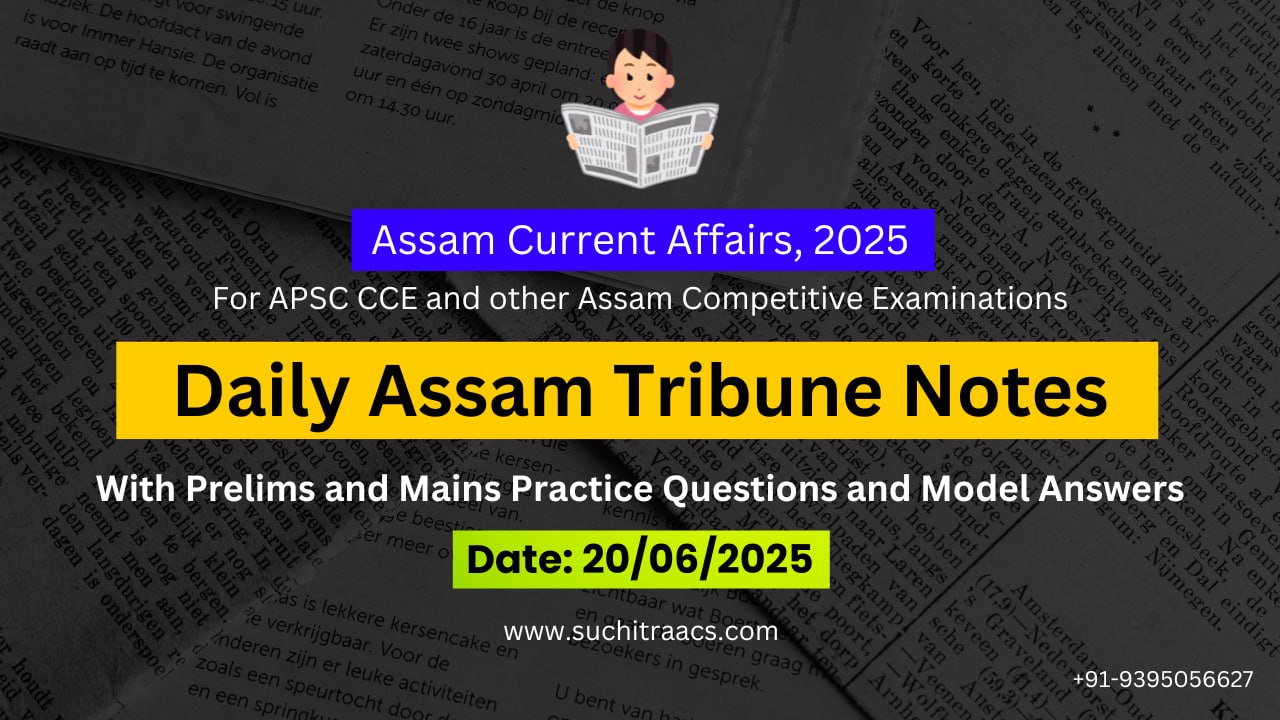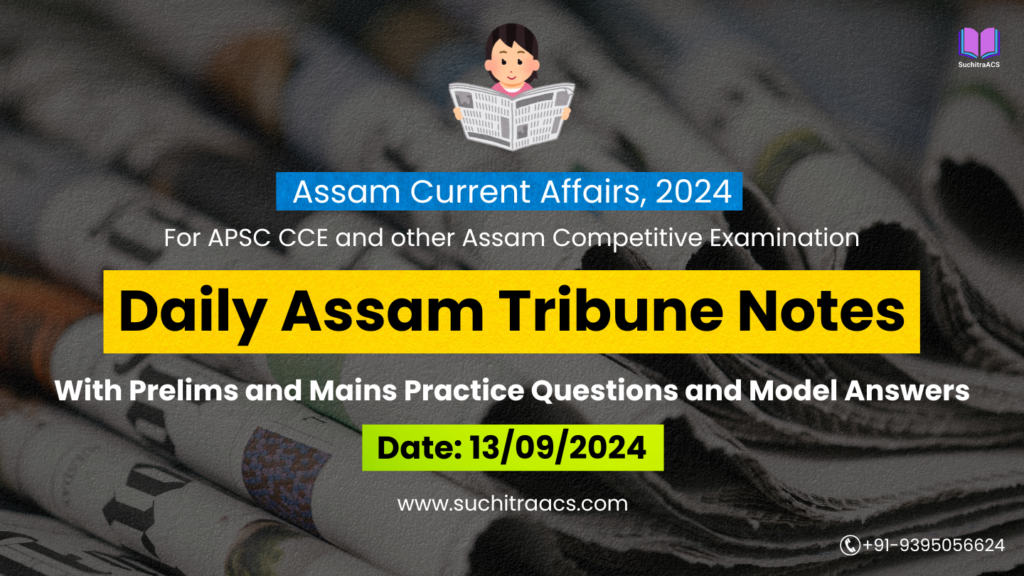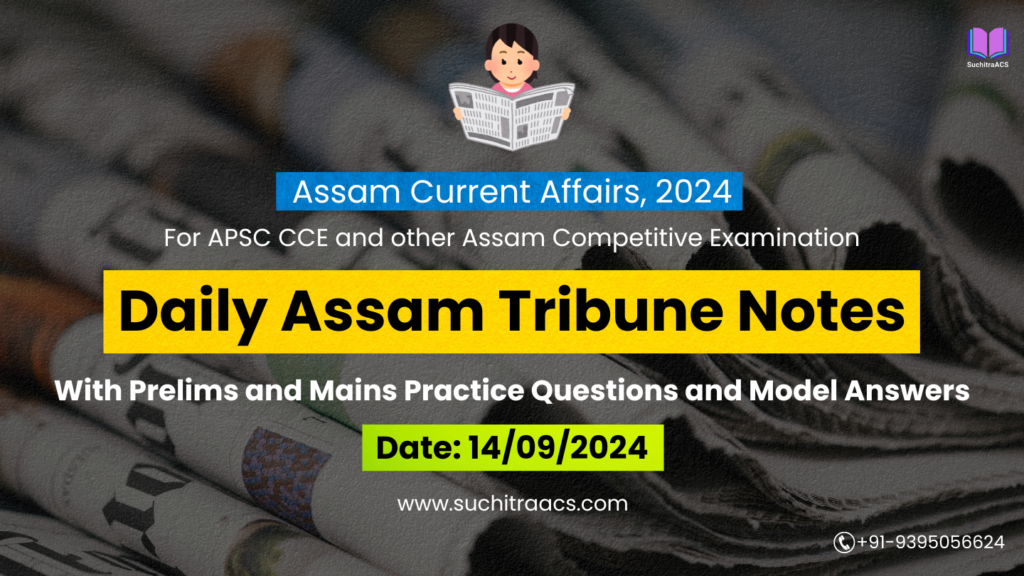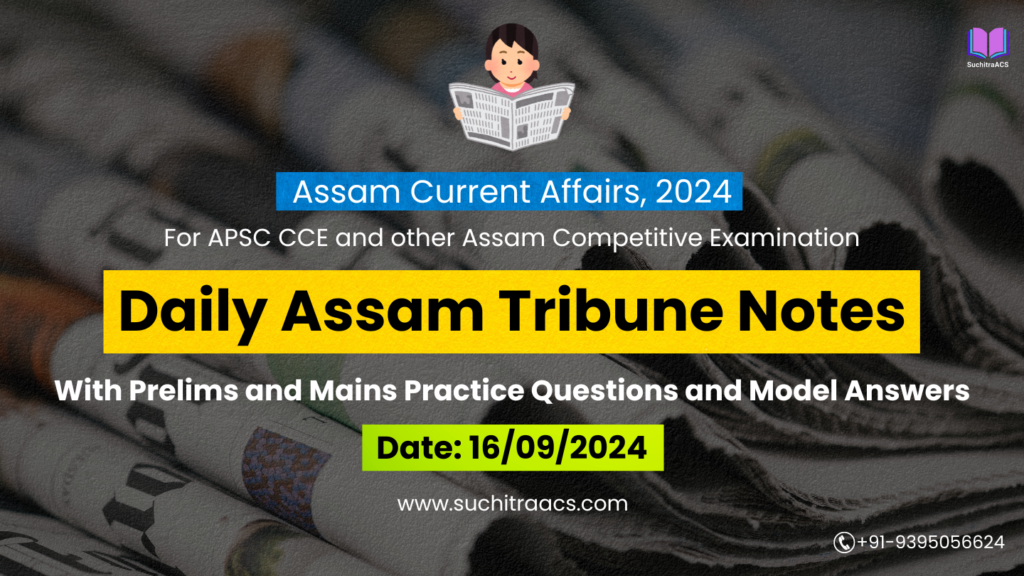APSC Current Affairs: Assam Tribune Notes with MCQs and Answer Writing (20/06/2025)
For APSC CCE and other Assam Competitive examinations aspirants, staying updated with current affairs is vital. This blog covers most important topics from the Assam Tribune today (20-06-2025). These issues are key for both APSC Prelims and Mains preparation, offering insights into the APSC CCE Syllabus.
✨ APSC CCE Online Coaching, 2026

🌊 Flood Hazard Mapping of Assam by ISRO: A Scientific Tool for Disaster Preparedness
📘 GS Paper 1: Geography – Disaster & Hazards
📘 GS Paper 3: Disaster Management | Environment | Science & Tech
📘 GS Paper 5 (APSC): Assam – Floods | Riverine Geography | Remote Sensing
🔹 Introduction
A new Flood Hazard Zoning Atlas prepared by the National Remote Sensing Centre (ISRO) in collaboration with NDMA and ASDMA has highlighted the extent and severity of flood-prone areas in Assam. Using multi-satellite data from 1998–2023, the atlas marks a significant step in scientific disaster planning for Assam.
🔑 Key Details
| Feature | Description |
| 🛰️ Prepared By | NRSC (ISRO) + NDMA + ASDMA |
| 🗓️ Data Period | 1998 to 2023 |
| 📍 Area Mapped | All 35 districts of Assam |
| 🌾 Crop Area at Risk | 18.22 lakh hectares |
| 🧭 Mapping Tool Used | IRS satellite data, international satellite charters |
| 📘 Atlas Name | Flood Hazard Zoning Atlas – Assam |
| 📊 Highest Risk Districts | Morigaon, Sivasagar, Bajali, Barpeta, Karimganj, Cachar |
| 🏞️ Village Coverage | 18,000+ villages categorized under 5 flood risk levels |
🧠 Prelims Pointers
ISRO’s NRSC: Nodal body for satellite-based natural disaster mapping
ASDMA: Assam State Disaster Management Authority
Flood Categories in Atlas: Very High, High, Moderate, Low, Very Low
NDMA: National Disaster Management Authority, under Ministry of Home Affairs
IRS Satellites: Indian Remote Sensing satellites, used for mapping and disaster support
📝 Mains Pointers
A. Significance of the Atlas for Assam
Offers scientific baseline for district-level disaster planning
Helps prioritise embankment, dredging, and relocation work
Supports climate-resilient agriculture and infrastructure
Enables early warning systems in vulnerable circles
Reduces disaster-related losses and relief delays
B. Insights from the Mapping
| Risk Category | Affected Area (ha) | Notable Districts |
| Very High | 3.26 lakh | Morigaon, Cachar, Charaideo |
| High | 2.86 lakh | Barpeta, Karimganj |
| Moderate | 4.65 lakh | Sivasagar, Nagaon |
| Low | 5.32 lakh | Goalpara, Dhubri |
| Very Low | 6.49 lakh | Upper Assam districts |
C. Challenges in Flood Mitigation
| Challenge | Description |
| River Dynamics | Brahmaputra’s shifting course & erosion |
| Siltation | Reduces carrying capacity of rivers |
| Encroachments | On wetlands and floodplains |
| Coordination | Between agencies (WR Dept., Revenue, ASDMA) |
| Funding Delays | For long-term infrastructure projects |
D. Government Measures & Schemes
Flood Early Warning Systems (FEWS) by ASDMA
SOPD Scheme for Embankment Repair
Mission Amrit Sarovar for wetland rejuvenation
River Basin Management Plans under Brahmaputra Board
Digital Elevation Models (DEM) by NRSC for future predictions
🧭 Way Forward
| Recommendation | Action |
| GIS-based Planning | Integrate flood atlas into panchayat-level planning |
| Community-Based DRM | Engage local youth & women’s groups |
| Smart Forecasting | Use AI for rainfall-runoff prediction |
| Flood-Resilient Crops | Promote short-duration varieties in high-risk zones |
| River Morphology Study | Annual review of river changes to guide embankment design |
🧩 Conclusion
The Flood Hazard Atlas is a major milestone in scientific disaster risk reduction for Assam. When integrated into policy, agriculture, and urban planning, it can transform flood-prone districts into resilient ecosystems through informed, proactive governance.
🧑⚕️ Medical Aspirants Protest Against Compulsory Rural Service Bond in Assam
📘 GS Paper 2: Health | Governance | Public Policy Implementation
📘 GS Paper 4: Ethics in Public Administration | Duty vs Rights
📘 GS Paper 5 (APSC): Assam – Health Infrastructure | Rural Development | Education
🔹 Introduction
Hundreds of MBBS aspirants in Assam protested against the mandatory rural service bond, which requires medical graduates from government institutions to serve in rural health centers for a minimum of 1 year post-graduation. The protest stems from a lack of infrastructure in rural postings and delays in policy clarity regarding NEET counselling and bond rules.
🔑 Key Details
| Aspect | Description |
| 🏥 Policy in Focus | 1-year compulsory rural posting for MBBS graduates from government colleges |
| 👨⚕️ Protesters’ Concern | Lack of facilities in rural PHCs, unclear counselling notifications |
| 📜 Existing Rule | Clause present in admission terms; implementation being intensified |
| 📆 NEET UG Counselling Delay | No formal notification; aspirants uncertain about bond terms |
| 🏛️ Legal Angle | States like Assam can enforce rural bonds under their health policies |
| 💬 State Govt Response | Indicated that bond will be enforced but facility improvements are ongoing |
🧠 Prelims Pointers
Rural Bond Service: Common policy in many states to ensure doctors are available in underserved areas
NEET UG: National-level entrance test for MBBS/BDS; counseling done by state DME
Assam Health Vision 2030: Focuses on increasing doctors per 1,000 population
NRHM (now NHM): National Rural Health Mission focused on PHC and CHC improvements
CAG Reports: Have pointed out vacant doctor positions in rural Assam exceeding 30%
📝 Mains Pointers
A. Need for Rural Posting Policy
Acute doctor shortage in PHCs and CHCs, especially in districts like Baksa, Dima Hasao
NHM schemes underutilised due to lack of medical officers
Reduces urban concentration of specialists
Aligns with right to health and equity for rural citizens
Acts as real-world training for young doctors
B. Ethical Dilemmas Involved (GS4 Overlap)
| Ethical Issue | Perspective |
| Public Duty vs Career Plans | Doctors are expected to serve the underserved, but many aim for PG seats |
| Equity vs Incentive | Should service be enforced or incentivised? |
| Transparency | Aspirants claim counselling info came late, violating informed consent |
| Fairness | Some feel rules differ between states, affecting meritocracy |
C. Challenges in Implementation
| Issue | Description |
| Lack of Facilities | Many rural postings lack hostels, lab support, electricity |
| Security Concerns | Night-time OPD duties in interior areas |
| No Structured Monitoring | State lacks real-time tracking of compliance |
| Postings Not Counted for PG | Rural year not linked with NEET PG advantage in Assam |
📑 Related Policies & Precedents
Supreme Court (2018): Upheld states’ right to mandate rural bonds
Tamil Nadu Model: Linked rural service with PG reservation
Assam Provincialisation Rules: Empowers state to manage postings
NHM HR Policy: Recommends bonded postings and contractual incentives
🧭 Way Forward
| Recommendation | Strategy |
| Infrastructure First | Upgrade rural PHCs before enforcing bond |
| Transparency in Rules | Clear pre-counselling disclosure of service terms |
| PG Reservation Linkage | Provide extra marks or quota in PG NEET for rural service |
| Incentive-Based Model | Use bonuses and fast-track promotion to attract talent |
| Mentorship Support | Assign senior doctors or telemedicine support in remote zones |
🧩 Conclusion
The rural service bond is a social contract to ensure health equity, but it must be matched with institutional support, transparency, and ethical balance. Rather than coercion, a mix of policy clarity, incentives, and empathy can make the program successful and socially just.
🛰️ ISRO to Launch Dedicated Climate Monitoring Satellite: INSAT-3DS
📘 GS Paper 3: Science & Technology – Space Technology | Climate Change
📘 GS Paper 1: Geography – Climate & Weather Systems
📘 GS Paper 5 (APSC): Assam – Disaster Preparedness | Technological Applications
🔹 Introduction
The Indian Space Research Organisation (ISRO) is preparing to launch INSAT-3DS, a dedicated satellite for climate monitoring, under the INSAT-3D series. This marks a critical advancement in India’s capacity for real-time weather forecasting, monsoon prediction, and climate disaster management — particularly relevant for flood-prone states like Assam.
🔑 Key Features of INSAT-3DS
| Feature | Description |
| 🛰️ Satellite Name | INSAT-3DS (Indian National Satellite – 3rd Gen) |
| 🏗️ Built By | ISRO’s UR Rao Satellite Centre (URSC) |
| 🧪 Payload | Meteorological Imager + Sounder + DCS (Data Collection System) |
| 🌍 Orbit | Geostationary – 36,000 km altitude |
| 📡 Use Cases | Monsoon tracking, cloud mass analysis, cyclone early warning |
| 🌧️ Regional Relevance | Beneficial for Assam’s flood forecasting and agriculture planning |
🧠 Prelims Pointers
INSAT Series: India’s multipurpose satellite series for weather, telecom, and disaster alert
Geostationary Orbit: Satellite remains fixed relative to a point on Earth’s equator
Meteorological Payloads: Include Imager, Atmospheric Sounder, and DRT (Data Relay Transponder)
IMD-ISRO Link: Indian Meteorological Department relies on INSAT data for forecasts
Global Context: Similar systems include NOAA (US), Fengyun (China), Meteosat (EU)
📝 Mains Pointers
A. Relevance for Climate-Vulnerable States Like Assam
Enables accurate early warning for floods and cloudbursts
Improves lead time for evacuation and relief planning
Assists in crop advisories for rain-fed farming areas
Supports monitoring of forest fires and droughts in hill districts
Enhances regional climate modeling for long-term planning
B. Role in National and Global Climate Monitoring
| Function | Explanation |
| Data Relay from Remote Areas | Enables monitoring in inaccessible Northeast & Himalayan zones |
| Monsoon Prediction Models | Inputs help improve Skymet, IMD and IITM rainfall models |
| Disaster Risk Reduction | Real-time cloud mass and temperature data reduce cyclone/flood impact |
| Carbon & Aerosol Monitoring | Adds atmospheric parameters for climate science research |
C. Integration with Disaster Management Plans
Assam’s Flood Early Warning System (FEWS) can plug into INSAT-3DS outputs
Supports ASDMA and NDMA in mapping seasonal risk areas
Satellite data improves panchayat-level micro-planning under Climate Resilient Agriculture Schemes
📑 Relevant Schemes & Institutions
National Monsoon Mission (MoES)
SAFAR (System of Air Quality and Weather Forecasting and Research)
State Action Plan on Climate Change (Assam)
Sendai Framework for Disaster Risk Reduction
GAGAN & NAVIC: India’s satellite navigation systems for precision agriculture & relief
🧭 Way Forward
| Recommendation | Strategy |
| Data Democratization | Make satellite-based alerts available via apps in Assamese/Bodo |
| Capacity Building | Train local officers in satellite data interpretation |
| Panchayat Integration | Use cloud cover alerts in MGNREGA, irrigation, and sowing cycles |
| Public-Private Innovation | Encourage agritech startups to use satellite inputs for Assam |
| Real-Time Dashboard | Develop user-friendly GIS dashboard integrating INSAT + ASDMA + IMD data |
🧩 Conclusion
INSAT-3DS is not just a technological milestone—it is a climate resilience enabler. For vulnerable states like Assam, it represents a bridge between satellite science and ground-level survival. The integration of such innovations into governance can transform disaster risk into proactive climate preparedness.
APSC Prelims Practice Questions
✅ Topic 1: Flood Hazard Mapping of Assam by ISRO
1. Which of the following agencies collaborated to prepare the Flood Hazard Zoning Atlas for Assam?
- ISRO
- NDMA
- ASDMA
- NESAC
Select the correct code:
A. 1, 2 and 3 only ✅
B. 1 and 4 only
C. 2, 3 and 4 only
D. 1, 2, 3 and 4
🧠 Explanation:
- The atlas was prepared by ISRO’s NRSC, along with NDMA and ASDMA.
- NESAC (North Eastern Space Applications Centre) was not specifically mentioned in this context.
2. The Flood Hazard Zoning Atlas categorizes villages based on:
A. Altitude and soil fertility
B. Number of embankments nearby
C. Satellite-detected flood recurrence and intensity ✅
D. Population density in flood-prone areas
🧠 Explanation:
Villages were categorized using satellite data from 1998 to 2023, into 5 categories based on frequency and intensity of past floods.
✅ Topic 2: Medical Aspirants Protest Against Compulsory Rural Bond
3. What is the main objective of enforcing a compulsory rural service bond on MBBS graduates?
A. To ensure higher competition in NEET PG
B. To improve the infrastructure of urban hospitals
C. To deploy trained doctors in underserved rural health centers ✅
D. To promote AYUSH and alternate medicine in villages
🧠 Explanation:
The purpose of the bond is to ensure that government-funded MBBS graduates serve in rural or tribal areas, where doctor shortages are most acute.
4. Which of the following constitutional provisions best supports the government’s right to mandate rural service for doctors?
A. Article 14 – Right to Equality
B. Article 19(1)(g) – Right to Practice Profession
C. Article 47 – Directive Principle on Public Health ✅
D. Article 30 – Rights of Minorities
🧠 Explanation:
Article 47 under DPSPs urges the state to raise the level of nutrition and public health—supporting policies like rural doctor bonds.
✅ Topic 3: INSAT-3DS – Climate Monitoring Satellite
5. What type of orbit will INSAT-3DS be placed in?
A. Low Earth Orbit
B. Sun-synchronous Orbit
C. Geostationary Orbit ✅
D. Polar Orbit
🧠 Explanation:
INSAT-3DS will operate in geostationary orbit (approx. 36,000 km altitude) to continuously monitor the same region over Earth.
6. Which of the following are expected benefits of INSAT-3DS for disaster management?
- Cyclone and flood early warnings
- Forest fire detection
- Aerosol and pollution monitoring
- Landslide zoning through ground radar
Select the correct answer:
A. 1, 2 and 3 only ✅
B. 1 and 4 only
C. 2 and 4 only
D. All of the above
🧠 Explanation:
INSAT-3DS provides real-time weather, flood, cyclone, pollution, and aerosol data—but landslide zoning requires ground or radar-based tools, not geostationary satellites.
APSC Mains Practice Question
📝 Mains Question:
Q. “Scientific tools like flood hazard zoning atlases can transform disaster management from reactive relief to proactive resilience.” Examine the role of space-based data in flood management in India with a special focus on Assam.
📘 Model Answer
Introduction
Floods are the most frequent and destructive natural disasters in India, affecting over 30 million people annually, with Assam among the worst-hit states. Traditionally reliant on post-flood relief, the state has now turned to scientific planning through space-based flood mapping. The recent Flood Hazard Zoning Atlas prepared by ISRO’s NRSC in collaboration with NDMA and ASDMA marks a crucial shift toward data-driven disaster preparedness.
Why Assam Needs Scientific Flood Management
- ~40% of Assam’s land is flood-prone
- 18 lakh hectares of cropland impacted annually
- Increasing flood frequency due to climate change and Brahmaputra siltation
- Lack of real-time early warning and long-term mitigation planning
Role of Space-Based Tools in Flood Management
| Tool or Application | Function |
| Satellite Mapping (IRS/INSAT) | Tracks flood extent, recurrence, and vulnerable zones |
| Digital Elevation Models (DEM) | Identifies low-lying areas for drainage planning |
| Flood Hazard Atlases | Classifies villages/districts by flood severity for zoning policies |
| Remote Sensing + GIS | Supports infrastructure planning (roads, embankments, shelters) |
| Cloud Cover & Rainfall Monitoring | Enables real-time flood alerts and crop advisory integration |
Benefits of the ISRO-Assam Flood Atlas
- Maps 18,000+ villages into 5 risk categories
- Covers flood data from 1998 to 2023, ensuring historical accuracy
- Enables prioritised funding and embankment work
- Helps reduce loss of life, livestock, and infrastructure
- Promotes climate-resilient agriculture through informed planning
Challenges in Integration
| Challenge | Explanation |
| Low Local Capacity | Panchayats and districts often lack GIS-trained officers |
| Coordination Deficit | Revenue, WR, and ASDMA departments work in silos |
| Funding Bottlenecks | Long-term flood mitigation projects often face delays |
| Encroachment on Floodplains | Weak land enforcement undermines hazard zoning |
| Data Accessibility | Scientific data often remains underutilised at grassroots level |
Way Forward
| Recommendation | Action Plan |
| Policy Integration | Make flood atlas part of district planning and MNREGA floodproofing |
| Digital Dashboards | Live flood data with public access for transparency and alerts |
| Capacity Building | Train local officials in reading satellite data and GIS tools |
| Community Engagement | Involve SHGs, youth, and schools in flood education |
| AI-Powered Forecasting | Integrate machine learning into rainfall-runoff models |
Conclusion
Space-based flood mapping is not just a scientific advancement—it is an equity tool for vulnerable regions like Assam. By enabling predictive governance, targeted resource allocation, and community resilience, such tools transform flood management from a humanitarian crisis to a solvable planning challenge. Science must flow into policy and reach the last mile to make this transformation real.
✨ APSC CCE Courses, 2025-26 offered by SuchitraACS


🔔 Join Our WhatsApp Study Group!
For exclusive access to premium quality content, including study materials, current affairs, MCQs, and model answers for APSC CCE and other Assam competitive exams.
Click here to join: SuchitraACS Study WhatsApp Group
📚 Want to know more about SuchitraACS’s most affordable courses?
Click here to know more: SuchitraACS Courses for APSC CCE and Assam Competitive Examinations




